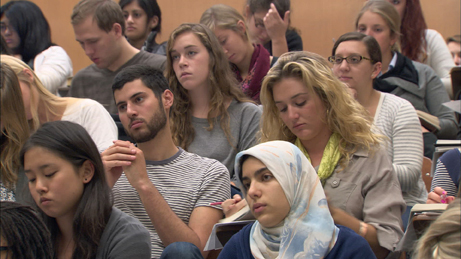At Berkeley is director Frederick Wiseman’s 38th film since 1967, in what he calls “my series about contemporary institutions.” His first on a college campus (the University of California at Berkeley) unfolds just over four hours. It’s a teaching lesson in the thoughtful strengths and the frustrating weaknesses of his fly-on-the-wall, observational-over-time technique of documentary filmmaking that he pioneered and has consistently pursued.
Filming 12 weeks on campus (not all in one semester), he shot 250 hours while wandering around the 36,000 students, 5,000 faculty and academic administrators, and more than 7,000 employees on the thousand-plus acre campus. At the New York Film Festival press conference, Wiseman said he picked this “great public university” because “public education is threatened.” The ominous outside pressures of reduced state funding (slashed in half over the past decade to 16 percent of the $2 billion-plus operating budget) besieges the campus like the shark in Jaws, and provides a storyline through to the last half hour that climaxes with a student demonstration against the cuts (amongst other vague demands) that resonates to Berkeley’s history as the birthplace of the influential 1960’s Free Speech Movement.
The fundraising office will be pleased that this renowned pinnacle of the ten campus state university system lives up to its reputation of high-level intellectual discourse, which is ostensibly the raison d’etre for the institution, including participatory humanities and social science seminars where professors pose challenging questions for serious discussion. Astronomy and biology lectures are attended by a lot of female science students, and star professor Robert Reich teaches public policy classes. Outside the classroom, there’s intriguing lab research in robotics technology and applause for guest luminaries reading poetry or reporting on breast cancer research.
The rhetoric of diversity comes up in history and economics of poverty classes, from administrators who emphasize maintaining financial aid (over 900 students receive federal Pell grants for tuition) and African-American students formally complaining about being socially excluded from informally organized study groups. But in a state where African-Americans are 7, Asians 14, and Latinos almost 40 percent of the state population, it’s surprising that the school, as seen here, looks like TV’s Glee, and is considerably less diverse than the City University of New York. Wiseman shows that another minority group has come together for mutual support—military veterans, who are adjusting both to school and their war experiences.
It’s admirable that Chancellor Robert J. Birgeneau gave Wiseman full access to all but tenure huddles, but much of the film is taken up with that bane of academic life–committee meetings. There’s either relentless hashing about the budget, including the impact on faculty recruitment and retention, or nervous planning for the demonstration. But a characteristic of so many committee meetings is that participants like to hear themselves talk, and here they come across as much as performers as the teachers, so not particularly subtle to the camera.
In contrast, what works best for Wiseman’s technique is his strolling unobtrusively around the beautiful grounds, where maintenance and capital improvements continue and the employment prospects of manual laborers contrasts with the future for the students hanging around halls in solitary study. (This must be the one campus anywhere with such few Public Displays of Affection.) Considerably into the film, an administrator explains that the landscape staff has been reduced to one mower, and the audience can’t help but cheer and salute his yeoman work when that one mower appears on screen.







Leave A Comment